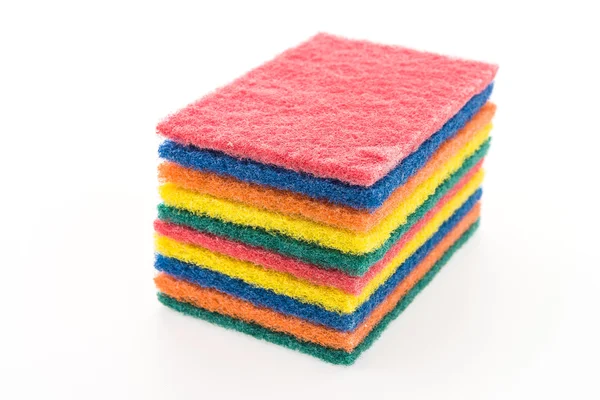Mastering the Use of an Abrasive Pad: A Comprehensive Guide
Abrasive pads, also known as sanding pads or scouring pads, are humble yet indispensable tools that find applications in a wide range of industries and DIY projects. Their versatility, ease of use, and ability to deliver precise results have made them a staple in workshops, construction sites, and homes alike. In this article, we delve into the various applications of abrasive pads and the essential role they play in achieving smooth surfaces, preparing materials, and delivering outstanding finishing results. We will also provide a step-by-step guide on how to use an abrasive pad effectively and efficiently.
If you need help finding an abrasive pad for any of the versatile applications listed below, see our product review article here.
Exploring the Versatility: The Various Applications of an Abrasive Pad
Surface Preparation in Painting and Coating Projects
Before applying paint, varnish, or any coating, surface preparation is crucial for a flawless finish and long-lasting results. Abrasive pads excel in this task by efficiently removing old paint, rust, and imperfections, creating a clean, smooth canvas for the new application. Whether it’s a small DIY painting project or a large-scale industrial coating application, abrasive pads make the surface preparation process more manageable and yield superior results.
Paint and Coating Removal
When you need to strip away old paint or coatings from surfaces, abrasive pads provide an effective and controlled method. From walls to furniture, metal surfaces, and even delicate pieces, abrasive pads offer the flexibility to tackle various materials, facilitating a swift and thorough paint and coating removal process.
Smoothing and Shaping in Woodworking
In the realm of woodworking, abrasive pads are indispensable tools for achieving smooth and even surfaces. They are ideal for sanding wood, shaping edges, and preparing the material for staining, varnishing, or finishing. With different grit options available, abrasive pads cater to various woodworking tasks, from heavy material removal to fine finishing.
Metalworking and Deburring
In metalworking, abrasive pads play a crucial role in deburring and cleaning metal surfaces. They can remove sharp edges, smooth welds, and prepare metal pieces for further processing, such as painting or polishing. Abrasive pads are also effective in restoring the shine and appearance of metal components, making them invaluable in industries like automotive, aerospace, and manufacturing.
Automotive Surface Preparation and Refinishing
Automotive professionals and enthusiasts turn to abrasive pads for a host of tasks. From surface preparation and paint removal to sanding bodywork, abrasive pads deliver consistent results. They are essential in auto body repair and refinishing projects, ensuring a smooth finish and optimal adhesion for new coatings.
Cleaning and Polishing
Abrasive pads are not just for material removal; they also have a place in cleaning and polishing tasks. When stubborn stains, mineral deposits, or grime need to be removed from various surfaces, abrasive pads rise to the challenge. They also find use in polishing metals, plastics, and other materials, resulting in a glossy, refined finish.
Home Improvement and DIY Projects
For DIY enthusiasts, abrasive pads are invaluable tools in home improvement projects. Whether it’s refinishing furniture, cleaning decks, or restoring household items, abrasive pads offer a cost-effective and efficient solution.
Preparation for Adhesive Bonding
Before adhesive bonding, surfaces often need slight roughening for improved adhesion. Abrasive pads are instrumental in preparing surfaces, ensuring better bonding and stronger adhesion between materials.
Rust and Corrosion Removal
In construction, maintenance, and restoration projects, abrasive pads prove their worth by effectively removing rust and corrosion from metal surfaces. This process not only enhances the appearance but also prolongs the lifespan of the materials.
In conclusion, the versatile applications of abrasive pads span across various industries and projects, proving their effectiveness in surface preparation, material removal, finishing, and cleaning tasks. Their ability to tackle different materials and their ease of use make them an essential tool in any toolkit. Whether it’s a professional tradesperson or a DIY enthusiast, the humble abrasive pad continues to deliver outstanding results and play an integral role in achieving high-quality finishes.
Step-By-Step Guide on How to Use an Abrasive Pad Effectively and Efficiently
Using an abrasive pad effectively and efficiently requires proper technique and attention to detail. Whether you’re preparing a surface for painting, smoothing wood, or cleaning metal, follow this step-by-step guide to get the best results with your abrasive pad:
Step 1: Choose the Right Abrasive Pad
Select the appropriate abrasive pad for your specific task. Consider the material you’ll be working on, the level of material removal required, and the desired surface finish. Choose the grit size that best suits your needs – finer grits for finishing, and coarser grits for material removal.
Step 2: Safety First
Before you start, put on safety gear, including safety glasses and a dust mask to protect your eyes and respiratory system from dust and debris generated during sanding.
Step 3: Prepare the Surface
Ensure the surface is clean and free from loose debris. If necessary, remove any old paint, varnish, or coatings using the appropriate abrasive pad or tool.
Step 4: Proper Grip and Pressure
Hold the abrasive pad firmly but not too tightly. Apply even pressure on the pad, distributing the force across the surface. Avoid excessive pressure, as it can lead to uneven sanding and may wear out the pad quickly.
Step 5: Choose the Right Technique
The correct sanding technique depends on your specific task. For large, flat surfaces, use long, even strokes in the direction of the grain (if applicable). For curved or contoured surfaces, use small circular motions or follow the shape of the surface.
Step 6: Consistent Movement
Keep the abrasive pad moving at all times during sanding to avoid creating gouges or uneven spots on the surface. Don’t dwell in one spot for too long. Instead, maintain a consistent sanding motion to achieve a uniform finish.
Step 7: Check Progress Regularly
Periodically stop sanding and inspect the surface to assess your progress. Check for any remaining imperfections or areas that need further sanding. Make adjustments as needed to ensure an even and smooth finish.
Step 8: Use Lighter Pressure for Finishing
When nearing the desired finish, reduce the pressure on the abrasive pad to achieve a smoother result. Lightly sand the surface using finer grits for a polished appearance.
Step 9: Clean the Surface
Once you’ve achieved the desired finish, clean the surface thoroughly to remove any sanding dust and debris. A clean surface is essential before applying paint, varnish, or any coating.
Step 10: Properly Store the Abrasive Pad
After use, clean the abrasive pad if possible and store it properly to extend its lifespan. If the pad is worn out or damaged, replace it to maintain optimal performance in future projects.
Step 11: Dispose of Waste Responsibly
Dispose of any sanding waste, such as dust and debris, according to local regulations and environmental guidelines.
By following this step-by-step guide, you can use an abrasive pad effectively and efficiently to achieve outstanding results in your various projects, whether it’s surface preparation, material removal, or finishing tasks. With the right technique and attention to detail, the abrasive pad becomes a powerful tool in your arsenal for achieving smooth and professionally finished surfaces.
Frequently Asked Questions
What is an abrasive pad generally made from?
An abrasive pad is generally made out of a combination of materials to create a flexible and abrasive surface suitable for material removal and surface preparation. The key components of an abrasive pad include:
- Abrasive Grains: The abrasive grains are the primary component responsible for the abrasive action of the pad. They are typically made from materials like aluminum oxide, silicon carbide, garnet, or diamond. The choice of abrasive grain depends on the desired grit size and the type of material it will be used to work on.
- Bonding Agent: The bonding agent holds the abrasive grains together and adheres them to the backing material. It provides the structural integrity and ensures that the abrasive grains remain securely attached during use. Common bonding agents include various types of resins, rubber, urethane, or a combination of these materials.
- Backing Material: The backing material forms the foundation of the abrasive pad and provides support and flexibility. The backing material can vary depending on the application and the level of flexibility required. Common backing materials include non-woven fibers, cloth, paper, plastic, or a combination of these materials.
- Additives and Fillers: Some abrasive pads may include additives or fillers to enhance specific properties, such as anti-clogging or heat resistance. These additives and fillers can improve the overall performance and durability of the abrasive pad.
The combination of these materials and their manufacturing process determines the effectiveness, durability, and versatility of the abrasive pad. Different abrasive pad formulations are designed to cater to specific applications, such as material removal, finishing, cleaning, or polishing, across various industries and DIY projects.
How does an abrasive pad work?
An abrasive pad works by using the abrasive grains embedded on its surface to remove material from the target surface through abrasion. When the pad is moved or pressed against the workpiece, the abrasive grains exert mechanical force, wearing down the material, and creating a smoother surface.
Here’s how an abrasive pad works:
- Abrasive Grains: The abrasive pad’s surface is covered with tiny abrasive grains made from materials like aluminum oxide, silicon carbide, or other abrasive compounds. These grains are harder than the material being worked on, enabling them to cut into the surface and remove material through abrasion.
- Material Removal: As the abrasive pad is moved or pressed against the workpiece, the abrasive grains scratch the material’s surface, breaking down and removing small particles. The material removal process depends on the grit size and the force applied to the abrasive pad. Coarser grits with larger abrasive grains are more aggressive and remove material faster, while finer grits with smaller abrasive grains provide a smoother finish.
- Flexibility and Adaptability: One of the advantages of abrasive pads is their flexibility and adaptability to various surfaces and contours. The backing material of the pad is often made from non-woven fibers, cloth, or other flexible materials, allowing the pad to conform to irregular surfaces and reach challenging areas.
- Heat and Dust Control: During the abrasive process, friction generates heat and dust. To prevent overheating and clogging, some abrasive pads are designed with special coatings or additives that control heat buildup and reduce dust accumulation. This helps maintain the pad’s effectiveness and extends its lifespan.
- Surface Finish: The selection of the abrasive pad’s grit size determines the surface finish achieved. Coarser grits remove more material but leave a rougher surface, while finer grits provide smoother and more polished finishes. By choosing the appropriate grit size, users can achieve the desired surface texture and quality.
- Versatility and Applications: Abrasive pads are versatile tools used in various applications, from surface preparation to material removal and finishing. They are commonly employed in woodworking, metalworking, automotive refinishing, and general maintenance tasks. The ease of use, portability, and cost-effectiveness of abrasive pads make them a popular choice for professionals and DIY enthusiasts alike.
Overall, an abrasive pad’s action is based on the abrasive grains wearing down the surface of the material through abrasion. By leveraging the right abrasive pad and technique, users can efficiently and effectively achieve smooth and refined surfaces for their specific projects.
What is the difference between a sandpaper pad and an abrasive pad?
The terms “sandpaper pad” and “abrasive pad” are sometimes used interchangeably, but they can refer to slightly different products. The main difference lies in their design and intended use. Here’s a breakdown of each:
Sandpaper Pad: A sandpaper pad typically refers to a piece of sandpaper attached to a rigid or semi-rigid backing material, such as foam, plastic, or wood. The sandpaper itself is a type of coated abrasive that consists of abrasive grains adhered to a paper backing. It is available in various grit sizes for different levels of material removal and surface finishing.
Abrasive Pad: On the other hand, an abrasive pad is a more general term that encompasses various abrasive products with a flexible backing material. It includes not only coated abrasives (like sandpaper) but also non-woven abrasives and abrasive pads made with other abrasive materials. Abrasive pads are designed to be flexible and conform to different surfaces, making them suitable for various applications beyond traditional sanding tasks.
In summary, the main difference between a sandpaper pad and an abrasive pad is that a sandpaper pad typically specifically refers to a piece of sandpaper attached to a rigid or semi-rigid backing, while an abrasive pad is a broader term that covers a range of abrasive products with flexible backings, including sandpaper. Both products serve similar purposes of material removal, surface preparation, and finishing, but abrasive pads may offer additional versatility in tackling different materials and surface shapes due to their flexible nature.
What are the four main types of abrasives?
The four main types of abrasives are:
Natural Abrasives: Natural abrasives are minerals or materials that occur in nature and are used in their natural form or with minimal processing. Examples of natural abrasives include:
- Emery: A naturally occurring mix of corundum and magnetite, often used for polishing and fine grinding.
- Pumice: A lightweight, porous volcanic rock used for finishing and cleaning.
- Sandstone: A sedimentary rock used for grinding and shaping softer materials.
Synthetic Abrasives: Synthetic abrasives are manufactured materials created through various industrial processes. These abrasives are engineered to have consistent properties and can be tailored to specific applications. Some common synthetic abrasives include:
- Aluminum Oxide: A tough and versatile abrasive used for grinding and polishing various materials.
- Silicon Carbide: A hard and sharp abrasive used for grinding metals, ceramics, and stone.
- Zirconia Alumina: A tough and durable abrasive often used for heavy material removal.
Bonded Abrasives: Bonded abrasives are abrasive grains held together by a bonding material. These abrasives are typically in the form of grinding wheels, honing stones, or other shaped abrasive products. The bonding material can be vitrified (glass-like), resinous (synthetic resin), or rubber-based, depending on the application. Bonded abrasives are commonly used in precision grinding, sharpening, and shaping operations.
Coated Abrasives: Coated abrasives consist of abrasive grains adhered to a flexible backing material, such as paper, cloth, or polyester film. The grains are held in place with adhesive, resin, or electrostatic bonding. Coated abrasives are widely used in hand sanding, portable belt sanders, and various power tools. Sandpaper is a common example of coated abrasives.
Each type of abrasive has specific properties and is suitable for different applications. The choice of abrasive depends on factors such as the material being worked on, the desired level of material removal, and the surface finish requirements. By understanding the characteristics of these four main types of abrasives, users can select the most appropriate abrasive for their specific tasks and achieve efficient and effective results.
editor's pick
news via inbox
Stay one step ahead with exclusive tips, guides, and offers delivered directly to your inbox.
Sign up for our newsletter and elevate your home improvement game today!


